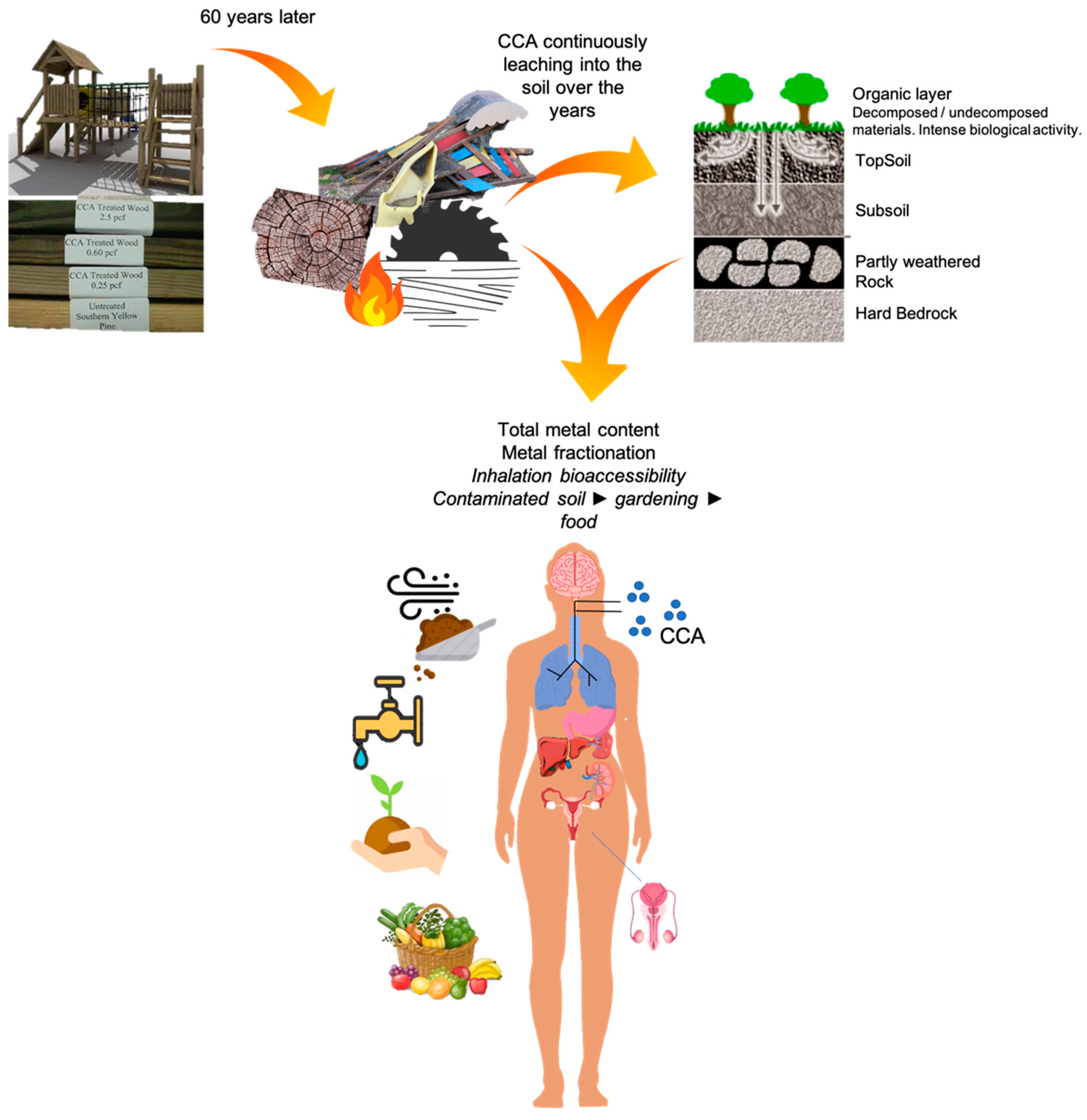Copper chrome arsenate (CCA) water-borne solution used to make timber is highly resistant to pests and fungi, in particular, wood products designed for outdoor use. Nowadays, CCA is a restricted chemical product in most countries, since potential environmental and health risks were reported due to dermal contact with CCA residues from treated structures and the surrounding soils. However, large quantities of CCA-treated timber are still in use in framings, outdoor playground equipment, landscaping, building poles, jetty piles, and fencing structures around the world, thus CCA remains a source of pollutants to the environment and of increasing toxic metal/metalloid exposure (mainly in children). International efforts have been dedicated to the treatment of materials impregnated with CCA, however not only does some reuse of CCA-treated timber still occur, but also existing structures are leaking the toxic compounds into the environment, with impacts on the environment and animal and human health.
- chromated copper arsenate
- CCA-treated wood
- arsenic
- chromium
- copper
- soils
- enviromental pollution
- public health
1. Introduction
 Figure 1. General overview of the potential environmental and human health impacts of chromated copper arsenate (CCA)-treated wood.
Figure 1. General overview of the potential environmental and human health impacts of chromated copper arsenate (CCA)-treated wood.2. Removal of CCA
3. Conclusions
This entry is adapted from the peer-reviewed paper 10.3390/ijerph18115518
References
- Chen, A.Y.-Y.; Olsen, T. Chromated Copper Arsenate–Treated Wood: A Potential Source of Arsenic Exposure and Toxicity in Dermatology. Int. J. Womens Dermatol. 2016, 2, 28–30.
- Coles, C.A.; Arisi, J.A.; Organ, M.; Veinott, G.I. Leaching of Chromium, Copper, and Arsenic from CCA-Treated Utility Poles. Appl. Environ. Soil Sci. 2014, 2014, 1–11.
- Gosselin, M.; Zagury, G.J. Metal(Loid)s Inhalation Bioaccessibility and Oxidative Potential of Particulate Matter from Chromated Copper Arsenate (CCA)-Contaminated Soils. Chemosphere 2020, 238, 124557.
- Katz, S.A.; Salem, H. Chemistry and Toxicology of Building Timbers Pressure-Treated with Chromated Copper Arsenate: A Review. J. Appl. Toxicol. 2005, 25, 1–7.
- Matos, R.C.; Vieira, C.; Morais, S.; de Lourdes Pereira, M.; Pedrosa, J. Nephrotoxicity Effects of the Wood Preservative Chromium Copper Arsenate on Mice: Histopathological and Quantitative Approaches. J. Trace Elem. Med. Biol. 2009, 23, 224–230.
- Matos, R.C.; Vieira, C.; Morais, S.; de Lourdes Pereira, M.; de Jesus, J.P. Nephrotoxicity of CCA-Treated Wood: A Comparative Study with As2O5 and CrO3 on Mice. Environ. Toxicol. Pharmacol. 2009, 27, 259–263.
- Matos, R.C.; Vieira, C.; Morais, S.; Pereira, M.L.; Pedrosa, J. Toxicity of Chromated Copper Arsenate: A Study in Mice. Environ. Res. 2010, 110, 424–427.
- Matos, R.C.; Oliveira, H.; Fonseca, H.M.A.C.; Morais, S.; Sharma, B.; Santos, C.; de Lourdes Pereira, M. Comparative Cr, As and CCA Induced Cytostaticity in Mice Kidney: A Contribution to Assess CCA Toxicity. Environ. Toxicol. Pharmacol. 2020, 73, 103297.
- Ohgami, N.; Yamanoshita, O.; Thang, N.D.; Yajima, I.; Nakano, C.; Wenting, W.; Ohnuma, S.; Kato, M. Carcinogenic Risk of Chromium, Copper and Arsenic in CCA-Treated Wood. Environ. Pollut. 2015, 206, 456–460.
- Takahashi, N.; Yoshida, T.; Kojima, S.; Yamaguchi, S.; Ohtsuka, R.; Takeda, M.; Kosaka, T.; Harada, T. Pathological and Clinical Pathological Changes Induced by Four-Week, Repeated-Dose, Oral Administration of the Wood Preservative Chromated Copper Arsenate in Wistar Rats. Toxicol. Pathol. 2018, 46, 312–323.
- US Environmental Protection Agency (US EPA). Notice of receipt of requests to cancel certainchromated copper arsenate (CCA) wood preservative products and amend to terminate certain uses of CCA products (22 February 2002). In Federal Register; U.S. Environ-mental Protection Agency, Office of Pesticide Programs: Washington, DC, USA, 2002; Volume 6, pp. 8244–8246. Available online: (accessed on 10 January 2021).
- Lansbury Hall, N.; Beder, S. Treated Timber, Toxic Time-Bomb: The Need for a Precautionary Approach to the Use of Copper Chrome Arsenate (CCA) as a Timber Preservative. Fac. Arts Pap. 2005, 1–49. Available online: (accessed on 10 January 2021).
- Peters, H.A.; Croft, W.A.; Woolson, E.A.; Darcey, B.; Olson, M. Hematological, dermal and neuropsychological disease from burning and power sawing chromium-copperarsenic (CCA)-treated wood. Acta Pharmacol. Toxicol. 1986, 59 (Suppl. 7), 39–43.
- U.S. Consumer Product Safety Commission. CCA-Pressure Treated Wood: Chromated Copper Arsenate: Guidance for Outdoor Wooden Structures. Available online: (accessed on 13 May 2021).
- Warner, J.E.; Solomon, K.R. Acidity as a factor in leaching of copper, chromium and arsenic from CCA-treated dimension lumber. Environ. Toxicol. Chem. 1990, 9, 1331–1337.
- Leduc, F.; Whalen, J.K.; Sunahara, G.I. Growth and Reproduction of the Earthworm Eisenia Fetida after Exposure to Leachate from Wood Preservatives. Ecotoxicol. Environ. Saf. 2008, 69, 219–226.
- Clausen, C.A.; Smith, R.L. Removal of CCA from Treated Wood by Oxalic Acid Extraction, Steam Explosion, and Bacterial Fermentation. J. Ind. Microbiol. Biotechnol. 1998, 20, 251–257.
- Clausen, C.A. CCA Removal from Treated Wood Using a Dual Remediation Process. Waste Manag. Res. 2000, 18, 485–488.
- Kartal, S.N.; Munir, E.; Kakitani, T.; Imamura, Y. Bioremediation of CCA-Treated Wood by Brown-Rot Fungi Fomitopsis Palustris, Coniophora Puteana, and Laetiporus Sulphureus. J. Wood Sci. 2004, 50, 182–188.
- Kim, G.H.; Choi, Y.S.; Kim, J.J. Improving the Efficiency of Metal Removal from CCA-Treated Wood Using Brown Rot Fungi. Environ. Technol. 2009, 30, 673–679.
- Dos Santos, H.S.; Ferrarini, S.F.; Flores, F.Q.; Pires, M.J.R.; Azevedo, C.M.N.; Coudert, L.; Blais, J.F. Removal of Toxic Elements from Wastewater Generated in the Decontamination of CCA-Treated Eucalyptus Sp. and Pinus Canadense Wood. J. Mater. Cycles Waste Manag. 2018, 20, 1299–1309.
- Velizarova, E.; Ribeiro, A.B.; Ottosen, L.M. A Comparative Study on Cu, Cr and As Removal from CCA-Treated Wood Waste by Dialytic and Electrodialytic Processes. J. Hazard. Mater. 2002, 94, 147–160.
- Jones, A.S.; Marini, J.; Solo-Gabriele, H.M.; Robey, N.M.; Townsend, T.G. Arsenic, Copper, and Chromium from Treated Wood Products in the U.S. Disposal Sector. Waste Manag. 2019, 87, 731–740.
